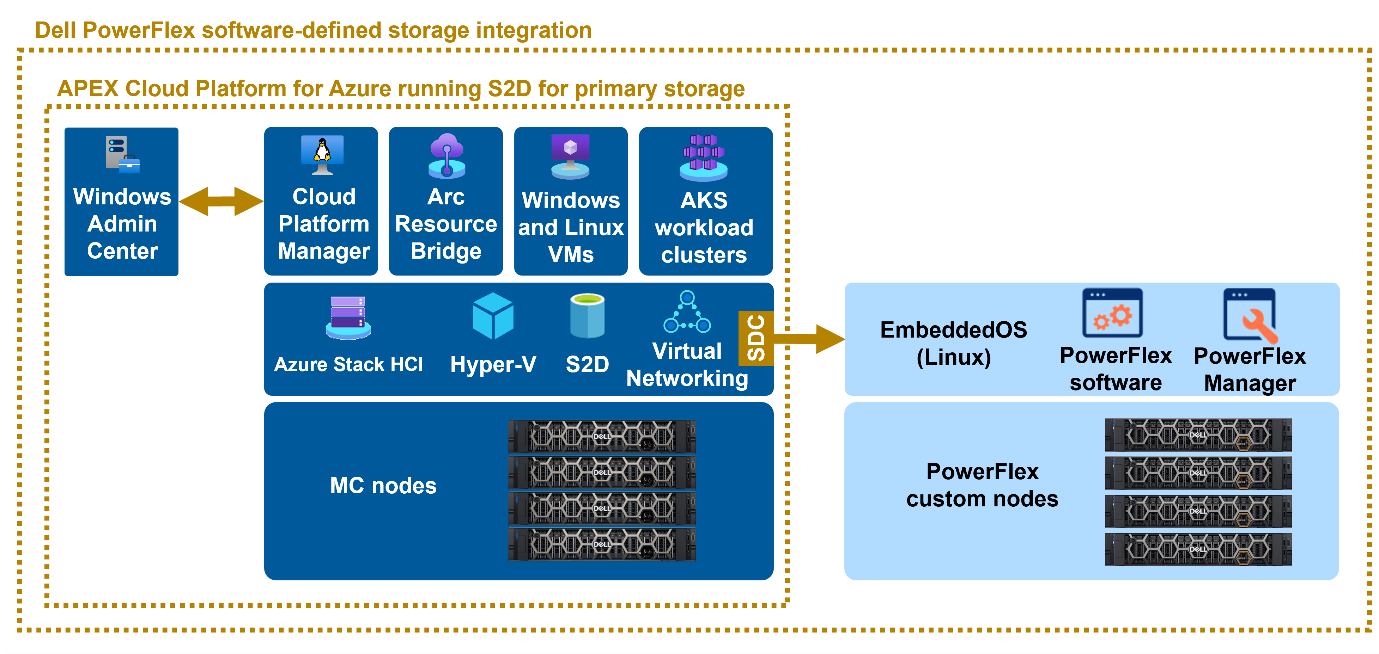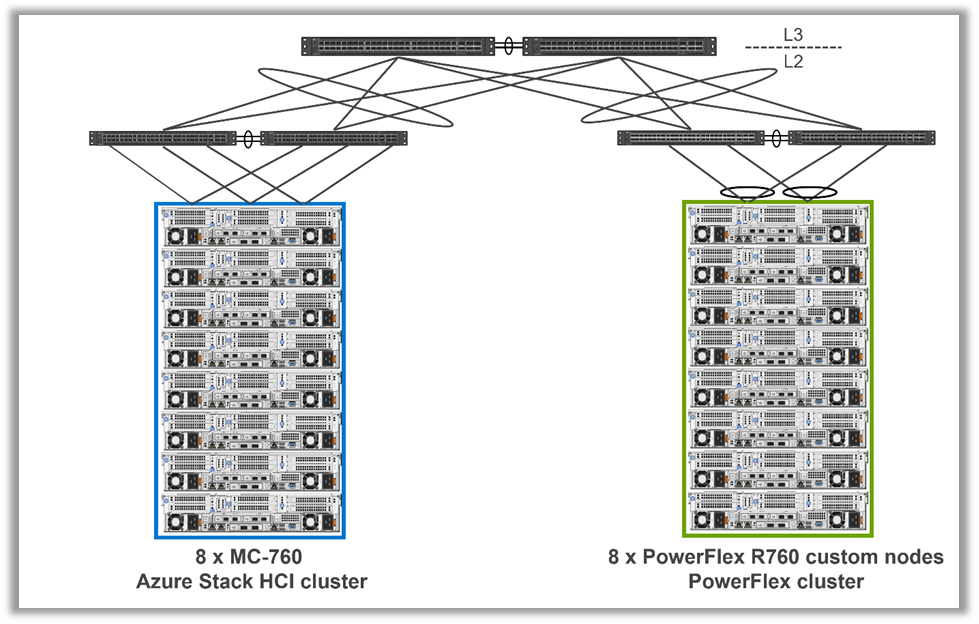Assets

What’s New in Dell APEX Cloud Platform for Microsoft Azure: Dell Software Defined Storage with Dell PowerFlex
Tue, 23 Apr 2024 17:10:13 -0000
|Read Time: 0 minutes
A few weeks ago, Dell Technologies announced a new release of Dell APEX Cloud Platform for Microsoft Azure that introduced a multitude of new features as well as support for Microsoft Azure Stack HCI version 23H2. Today, we are announcing the availability of a new architectural option for Dell APEX Cloud Platform for Microsoft Azure customers – extending the Azure Stack HCI storage fabric to Dell PowerFlex software-defined storage
Dell APEX Cloud Platform for Microsoft Azure has an architecture designed around common building blocks for compute, software-defined storage, and automated management and operations.

Figure 1. Dell APEX Cloud Platforms common infrastructure
The new capability offers customers the unique advantage of having the flexibility to utilize Microsoft Storage Spaces Direct (S2D) alongside Dell PowerFlex, Dell Technologies’ enterprise-class software-defined storage option. APEX Cloud Platform for Azure is the only offer in the Microsoft Premier Solutions for Azure Stack HCI category that supports linear scaling of storage independently from Azure Stack HCI resources. APEX Cloud Platform for Azure with PowerFlex utilizes PowerFlex storage nodes for block storage. Any of the Dell PowerFlex product variants—rack, appliance, or custom node—can be utilized to satisfy the solution. PowerFlex provides a multitude of essential features:
- Ability to host a wide range of business workloads, including:
- Mission-critical databases and applications that require high transactional performance and low latency
- Applications that require consistent I/O performance, such as those used for streaming, ingestion, and reporting transactions within AI and data analytics environments
- Highly-available platform at six 9s (99.9999%), which translates to just 31.5 seconds of platform downtime a year. On top of that resiliency, the platform incorporates exceptionally fast rebuild and rebalance operations.
- Modular scale-out architecture, built to support exponential data growth
This new storage option, designed to co-exist with—not replace—Microsoft S2D, has been tested in a proof of concept by both Dell Technologies and Microsoft engineering teams, ensuring that the solution supports the uses cases and features described previously.
“As we continue to innovate and empower our customers with cutting-edge solutions, the partnership with Dell and Microsoft is paramount. With the Dell APEX Cloud Platform for Microsoft Azure, customers gain great flexibility and simplicity by leveraging Microsoft Storage Spaces Direct alongside Dell’s enterprise-class software defined block storage. By integrating Microsoft Azure Stack HCI with Dell software-defined block storage, this solution gives businesses the autonomy to deploy workloads across on-premises and in the Azure cloud.” – Meena Gowdar, Group Principal PM Manager, Azure Edge and Platform, at Microsoft.
The architecture of the tested solution is illustrated in the following figure:

Figure 2. Dell APEX Cloud Platform for Microsoft Azure with Dell PowerFlex high-level architecture
As you can see in Figure 2, the components of a Microsoft S2D-only option overlap completely with the option integrating Dell PowerFlex custom nodes.
This architecture has been designed with the following principles in mind:
- High availability – designed to avoid single points of failure in the compute, storage, and networking domains
- Scalability – enabling you to size the infrastructure accordingly to meet initial deployment demands while also allowing infrastructure assets to grow as demand scales up
- Manageability – leveraging a set of familiar tools to manage the environment
- Simplicity – providing a seamless experience for presenting this new external storage to Azure Stack HCI for IT administrators already familiar with S2D
Tested configuration
The Dell Technologies engineering team performed the testing and validation of the PowerFlex storage configuration using the following building blocks:
- Eight MC-760 HCI nodes
- Eight Dell PowerFlex R760 custom nodes
This was deployed and connected as shown in the following figure:

Figure 3. Dell SDS validated configuration
Note: A fully-supported Dell Validated Design will be available at a later date, providing a more complete set of guidance for configuration, deployment, and design.
To learn more, read the detailed architectural white paper, Enabling Mission Critical Workloads on APEX Cloud Platform for Azure with Dell PowerFlex.
For more information on Dell APEX Cloud Platform for Microsoft Azure, please check the Resources section.
Resources
- Enabling Mission Critical Workloads on APEX Cloud Platform for Azure with Dell PowerFlex
- YouTube Playlists about Dell APEX Cloud Platform for Microsoft Azure:
- White papers, blogs, videos, and interactive demos about APEX Cloud Platforms
- Dell APEX Cloud Platform for Microsoft Azure main product page
- Dell APEX Cloud Platform for Microsoft Azure Support site with official user manuals and guides
Author: William Leslie, Director, Cloud Platform Technical Marketing
X: @williamleslie8

